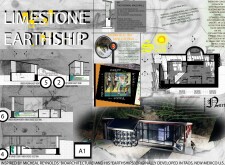5 key facts about this project
### Overview
The Limestone Earthship is a contemporary architectural endeavor situated in Taos, New Mexico, which exemplifies the principles of bioarchitecture developed by Michael Reynolds. This design integrates sustainable building practices with functional aesthetics, emphasizing ecological balance and self-sufficiency. The structure is conceived as a self-sustaining habitat that effectively manages environmental resources.
### Material Utilization and Sustainability
The project employs a variety of materials designed for sustainability and performance. Limestone blocks, measuring 2' x 6', serve as the primary thermal mass, providing natural insulation and stabilizing indoor temperatures across varying climates. A solid concrete foundation supports the structure's durability, while selective brick finishes enhance the visual quality in communal areas. Photovoltaic solar panels and a thermoelectric satellite dish for capturing solar thermal energy contribute to the building's energy independence. Additionally, rainwater catchment systems integrate water sustainability by harvesting rainfall for reuse.
### Spatial Organization and User Experience
The spatial layout is centered around a "Great Room," which serves as the core communal space, flanked by functional areas such as kitchens, bedrooms, and storage. The design features a thermal mass wall that moderates indoor temperatures and an earth berm wall at the rear for added thermal insulation. Generously sized windows facilitate natural light and foster connections between indoor and outdoor environments. Furthermore, dedicated green rooms enhance indoor biodiversity, promoting improved air quality. The project harmonizes modern architectural forms with natural materials, providing an aesthetically pleasing exterior that complements the local landscape.


















































